| Image (Click to enlarge) |
Model |
Year |
Description |

|
Triode or "Audion" tube |
1906 |
In 1907 De Forest patented a bulb with the same contents as the Fleming diode, except for an added electrode. This "grid" was a bent wire between the plate and filament. De Forest discovered that if he applied the signal from the wireless-telegraph antenna to the grid instead of the filament, he could obtain a much more sensitive detector of the signal. |
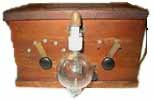
|
RJ4 |
1909 |
The first amplified radio ever made. |
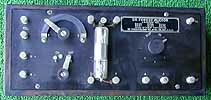
|
RJ8 |
1910 |
|
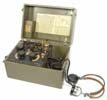
|
SCR54A |
1918 |
During World War I, amateur broadcasting was forbidden in the United States and DeForest Radio Telephone & Telegraph was contracted to build receivers for the US Signal Corps, which was successfully using radio communication in the field for the first time in history. |
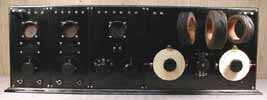
|
M200 |
1921 |
|
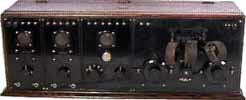
|
MR-6 Interpanel |
1921 |
|
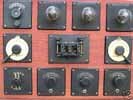
|
INTERPANEL |
192? |
|
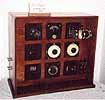
|
9 Panel |
1922 |
|
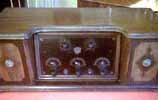
|
D5 |
1922 |
|
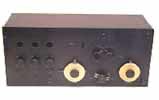
|
D6 |
1922 |
|

|
DT600 |
1922 |
|

|
DT700 |
1922 |
Single tube radio. |

|
DT800 |
1922 |
Among the scarcest items ever to ship out of de Forest's Jersey City factory. Designed to pair up with Deforest's DT-700 radiohome receiver, this two-stage amplifier comes in a walnut cabinet identical in size and shape to that of the DT-700, with audio inputs positioned to correspond with the audio outputs of the radiohome. The connection diagram on the inside of the lid details how the two components are to be connected to each other and to the battery supplies. |
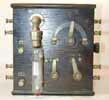
|
UJ2 |
1922 |
|
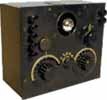
|
Radiocraft Radiophone |
1922 |
Radiocraft was purchased by DeForest in 1922 as a means to acquire rights to the Armstrong regeneration patent. Unfortunately, Westinghouse apparently didn't approve transfer of the patent license and the Radiocraft models were discontinued after a short time. Today they are very hard to find. This set was produced by DeForest under the Radiocraft name shortly after the Radiocraft acquisition. |

|
D7 |
1922 |
|
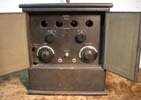
|
D10 |
1923 |
|

|
D12 |
1923 |
Contains a crystal detector and 4 tubes, rather than being a 5 tube set. Not many of these were sold. The 4 tube model was redesigned into a 5 tube set and the crystal detector eliminated. Then the 4-tubers were recalled and traded straight across for one of the 5 tube sets, which makes those D-12s that still have the detector an especially rare set, much more so than the 5 tube model. The circuit for this set is almost identical to the D-10, which it is sometimes confused with because of that. |
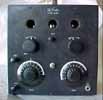
|
D7A |
1923 |
3 tube radio. |
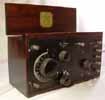
|
DeForest-Crosley 51 |
1924 |
Wood case. Bakelite front. It has spider web coils and uses 2 WX12 tubes. |
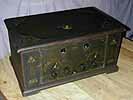
|
D17 |
1924 |
|
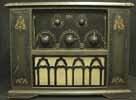
|
F |
1924 |
|
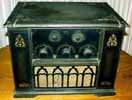
|
F5 |
1925 |
|
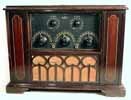
|
F5M |
1925 |
|
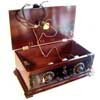
|
Trirdyn |
1925 |
|
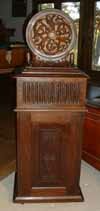
|
W5 |
1925 |
55" high x 19 1/2" wide. |
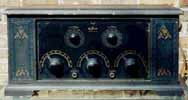
|
F5AL |
1925 |
|
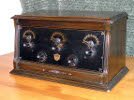
|
C5 |
1926 |
|

|
602 |
1929 |
Fidelity series, Neutrodyne, Batteryless Receiver, AM. It has 7 tubes (types 80, 71A, 27 and four type 26 tubes). The radio has a nice flip top that latches open automatically. 115V, 60 watts, 25-60 cycles, patent 1924,26,27. |
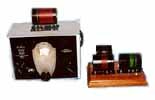
|
UNKNOWN08 |
1930 |
De Forest radiophone receiver manufatured in 1930 in Passaic, NJ. The radio tunes from 1.5 to 20 Mhz. with bandswitching via the plug in coil set pictured. |
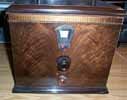
|
UNKNOWN14 |
1930 |
2 tube short wave converter made by Deforest Crosley in Canada. Deforest products made in Canada are much rarer than their US counterparts, and often had a similar US product. Wood cabinet. Converter covers 1.5mc to 22mc in 3 bands. Measures 11.5" wide, x 9" deep by 10" high. |

|
608A |
1932 |
37.5 x 21.9 x 12.15 inches |
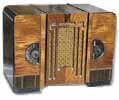
|
B8 |
1934 |
|
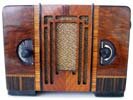
|
81 |
1935 |
Wood with different veneers, made by Knechtel Furniture Co. Ltd. Hanover, On, Canada. 6A7 (mod. osc.), 88 (IF), 6B7 (AF det.), 41 (AF), all original spray-shield, 80 (rect.) 13" x 8" x 10". 22 pounds |

|
1523 |
1935 |
16 3/4 inches high, 12 1/2 inches wide & 8 1/2 inches deep |

|
CONNAUGHT |
1936 |
3 Bands: AM, Shortwave and a Police Band. The "Connaught" was Deforest Crosley's top of the line table model set for 1936. It was actually manufactured by Rogers Majestic Limited of Toronto and shares the same chassis as the Rogers model "Ten-60" and the Majestic "Jolliette". The information label attached to the inside of the radios cabinet identifies this model as the "Connaught" while the schematic for this set, found in the Radio Collage of Canada books, identifies this set as the "Connought". Tuning on this radio is aided by a special 24 volt light bulb mounted on the dial that would stay lit but would dim as soon as a station is tuned in. 21(H) x 15(W) x 11.25(D) Measures 21 inches tall and 11.5 inches wide and 15 inches in length. The radio weighs about 50 pounds. |
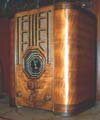
|
6D531 |
1937 |
DeForest-Crosley police band SW "Tombstone" "Meteor" radio. Measures 18"Hx15"Wx9.5"L |
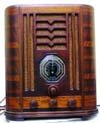
|
6D632 |
1937 |
The "Electra" was Deforest Crosley's top of the line table model set for 1937 and shares the same chassis, type 6D632, as the DeForest Crosley "Mars" console. This radio was actually manufactured by Rogers Majestic Limited of Toronto and shares the same chassis as the Rogers model "11-60, 11-65, 11-66, (type 6R632 chassis), 11-68, 11-69, (type 6R631 chassis)" and the Majestic "Rodney, Renown, and Hood". Tuning on this radio is aided by a special light bulb mounted in the center of the tuning needle stay lit but would dim as soon as a station is tuned in. 21(H)x 19.25(W) x 10.25(D) |
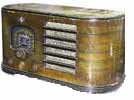
|
7D933 |
1937 |
Tubes: 2X3 (2), 6F6M, 6F5M, 86M, 6K7M (2), 6A7M, 6X6 Power: 25/60-cycle |

|
7D634 |
1938 |
|

|
7D832 |
1938 |
|

|
8D722 |
1938 |
7-tube, 2X3 (Qty 2, rectifier), 6X6 (tuning indicator), 6J8M (Modulator-Oscillator), 6K7M (IF Amp), 75M (2nd Detector and audio amp), 41M (Output). 2 Bands: AM (Broadcast), Short Wave 38 ½" high, 24" wide, 11" deep, 66lbs |
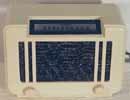
|
MINIRADIO |
1939 |
|
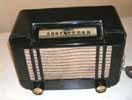
|
MINIRADIO2 |
1939 |
|

|
10D691 |
1940 |
Tubes: 20J8M, 12K7M, 12B6M, 50C6G, 50Y6G, 6X6 Power: 60-cycle |
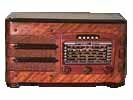
|
10DA561 |
1940 |
Made for De Forest Radio by Rogers-Majestic. |
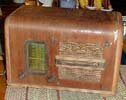
|
10D451 |
1941 |
|
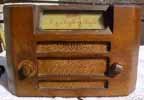
|
D566 |
1945 |
115 Volts,35 watts, Type 51 DU245. 13 3/4" Long X 9 1/8" Tall 7" deep. Bakelite knobs. |
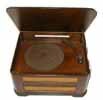
|
78RPM |
1945 |
|

|
D547 |
1946 |
The dimensions are 27" X 16" X 9". |
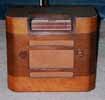
|
D806 |
1946 |
5 tube Broadcast band |
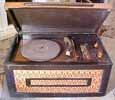
|
D607 |
1947 |
22 x 14 x 11 inches |
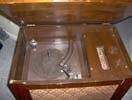
|
D627 |
1947 |
5 tube model radio 14B6 - 14A7 - 14Q7 - 35Z5GT and 50L6GT. |
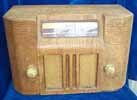
|
D837 |
1947 |
The case is made of oak wood. Radio measures 9"H x 14"W. |
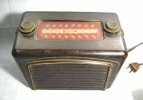
|
D518 |
1948 |
|

|
DeForest-Crosley 5-01As & Crosley Ultra Musicone Speaker |
19?? |
|

|
LS300 Speaker |
19?? |
The diameter of the bell is 14 1/2". |
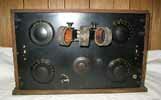
|
UNKNOWN01 |
19?? |
7.5" tall 12.5" wide and 5.5" deep. It weighs 9 lbs. |
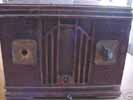
|
UNKNOWN02 |
19?? |
115 amps, 6 cycles, 25-60 type Wood cabinet. 12"L x 7"W x 9.5"D. |

|
UNKNOWN03 |
19?? |
37.6 x 20.45 x 10.45 inches |
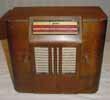
|
UNKNOWN05 |
19?? |
|
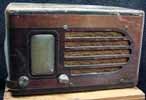
|
UNKNOWN06 |
19?? |
|
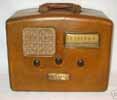
|
UNKNOWN09 |
19?? |
AC/DC and battery. Portable. |
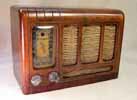
|
UNKNOWN13 |
19?? |
Measures: 9.5" wide, 7.5" high, and 5.5" deep. |
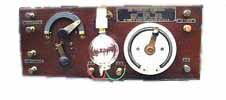
|
RJ9 |
1910s |
|
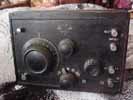
|
DeForest-Crosley 50 |
192? |
Made by De Forest Radio Corp. in Toronto, Canada in the 1920's. Uses only one tube, a UV-201A by RCA. |
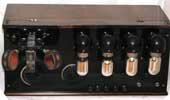
|
UNKNOWN11 |
192? |
|

|
UNKNOWN12 |
192? |
|
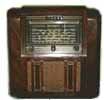
|
56/42 |
193? |
|

|
6D471 |
193? |
|
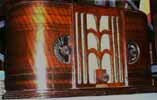
|
6D511 |
193? |
|
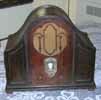
|
CATHEDRAL |
193? |
Weighs 40 lb 18 X 18 X 10 inches |

|
DeForest-Crosley "Mission"? |
193? |
35" height, 19" wide, 14" deep. |

|
NAPOLEON |
193? |
|
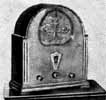
|
ROYAL MIDGET |
193? |
|

|
10DA521 |
194? |
|

|
10DA522 |
194? |
|
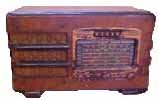
|
10DB661 |
194? |
These radios were made from 1923 to 1940 by the Rogers Majestic co. for the De Forest Crosley co. The radio measures 17" long by 8" wide by 10" high. |
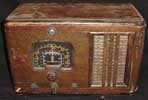
|
7D731 |
194? |
DeForest Crosley 3 Band (Short Wave / Overseas, Police & Standard Broadcast), 7 tube radio. 24" X 14" X 10" in size and weighs about 35 pounds. |
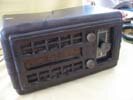
|
8D512 |
194? |
Bakelight. Weighs 16lbs 8 oz. and measures 14 x 8 x 8 inches. |
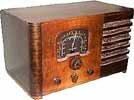
|
8D662 |
194? |
25.9 x 16.3 x 9.05 inches |

|
8D891 |
194? |
|
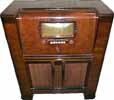
|
9D891 |
194? |
36.1 x 29.9 x 12.75 inches |

|
ELECTRA |
194? |
The wooden cabinet is 19 1/2" high and 16" wide and 10" deep. The radio is 100 volts, 57 watts, 25-60 cyc. Type or model -6D632, Manufactured by Rodgers-Majestic Coorperation Limited, Toronto, Canada for De-Forest-Crosley limited. |
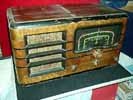
|
80721 Shortwave |
194? |
12"H x 23"W x 9.5"D 5 tube |
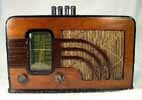
|
St. Regis |
194? |
11.5"W x 7"H x 5"D |
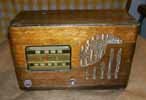
|
UNKNOWN10 |
194? |
|

